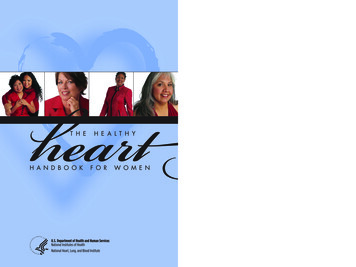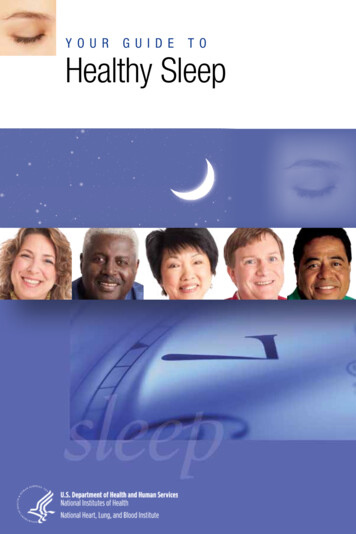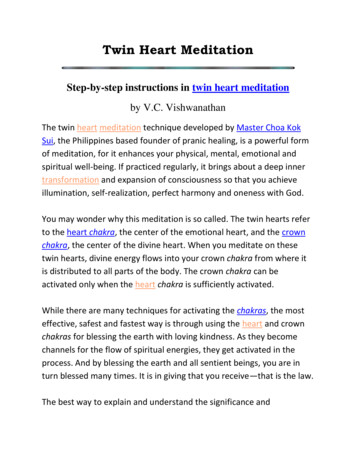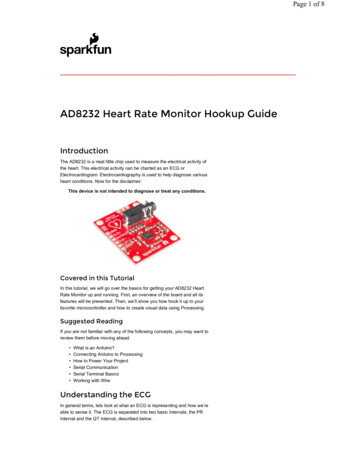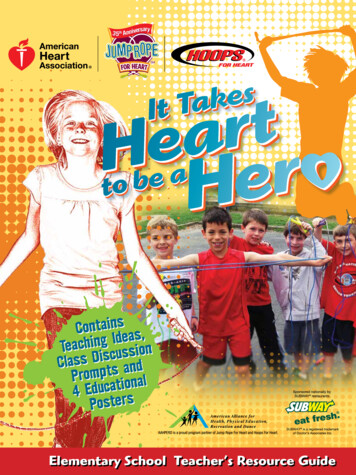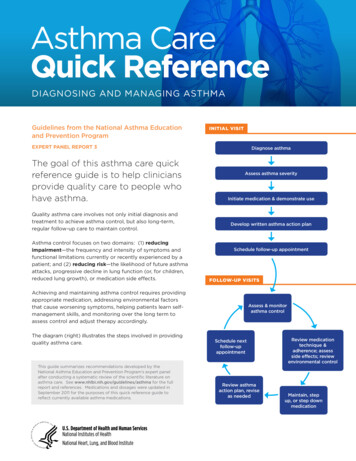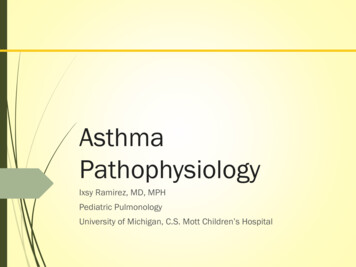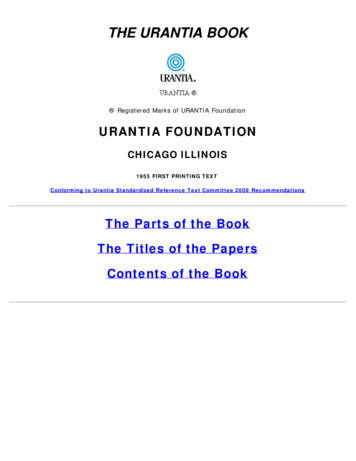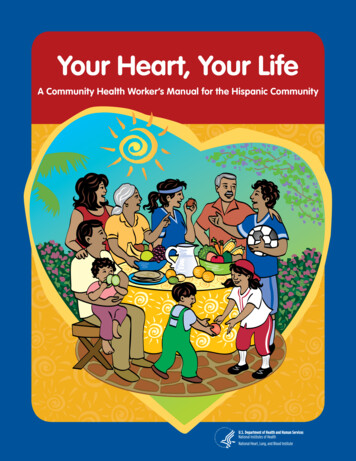
Transcription
Your Heart, Your LifeA Community Health Worker’s Manual for the Hispanic Community
NIH Publication No. 08-3674Originally Printed 1999Revised May 2008
You Are Unique in This WorldDedicated to Community Health WorkersAlmost prancing, joyful and dancingYou walk our streets observing, yearning to know, eager to share.Dreaming to see in the light of the dawn, your dream come true:Our world better off.You are unique in this world, and you don’t even know it.To the neighborhood and family you surrender your heart.No one at all is beyond the reach of your hands.With heartfelt voice proclaiming, you offer hope, courage, and health.You are unique in this world, and you don’t even know it.Heart health is the key, and you now know it well.“Let’s better your health!” is your battle cry.You are our hero, our neighborhood inspiration.You are unique in this world, and you don’t even know it.You know how hard it is to change your ways.The way we used to sit around. The use of too much salt and lard.Those now belong to days gone by.You are our leader, your family and neighborhood salute you.You are unique in this world, and you don’t even know it.You are a great listener.You are the one who knows how we feel and understands our pain.You are the one who has courage to challenge for change in our world.Today is the day! I’m telling you now!You are unique in this world, and I want you to know it.Poem written by Gloria Ortiz, National Heart, Lung, and Blood InstituteEnglish translation by Ariela C. Rodriguez, Ph.D., A.C.S.W.
Ta b l e o f C o n t e n t sDear Community Health Worker Letter. vintroductionThe Role of the Community Health Worker. viAcknowledgments. xiAbout the “Your Heart, Your Life” Manual. xvHow To Use This Manual. xviisession 1Are You at Risk for Heart Disease?. 1session 2Act in Time to Heart Attack Signs. 19session 3Take Heart: Say YES to Physical Activity. 43session 4Help Your Heart: Control Your High Blood Pressure . 73session 5Be Heart Smart: Keep Your Cholesterol in Check.111session 6Keep Your Heart in Mind: Aim for a Healthy Weight. 155session 7Protect Your Heart: Take Good Care of Your Diabetes for Life . 189Your Heart, Your Life: A Community Health Worker’s Manual
session 8Make Heart Healthy Eating a Family Affair. 233session 9Eat in a Heart Healthy Way—Even When Time or Money Is Tight. 263session 10Enjoy Living Smoke Free. 285session 11Review and Graduation. 315session 12Use Evaluation To Track Your Progress (Especially for Promotores) . 343appendixActivities for Training Community Health Workers . 401for more information. 441Your Heart, Your Life: A Community Health Worker’s Manual
Dear Community Health Worker:Cardiovascular disease (CVD) is the #1 killer of all Americans, including Latinos. Sadly,nearly one out of four Latinos dies of heart disease. High blood pressure, high bloodcholesterol, obesity, smoking, physical inactivity, and diabetes are all factors that increase aperson’s risk of CVD. The good news is that people can lower their risk by making somelifestyle changes, and community health workers (promotores de salud) like you can help.The “Your Heart, Your Life” manual can guide you as you begin this journey.“Your Heart, Your Life” is a heart health manual created especially for Latino communitiesby the National Heart, Lung, and Blood Institute (NHLBI) at the National Institutes of Health(NIH), U.S. Department of Health and Human Services (DHHS). The manual is taught bycommunity health workers and focuses on helping people build skills to make practical,lasting changes to help fight heart disease and to improve their health.The “Your Heart, Your Life” manual provides all the information you need to put this hearthealth project into action in your community. This manual can be used to train communityhealth workers as well as to educate members of the Latino community, or it can serve as thebasis for other community activities.“Your Heart, Your Life” is dedicated to community health workers like you who devotetime and energy to help others improve their health and live longer. Thank you for makinga difference.Much success,Robinson Fulwood, Ph.D., M.S.P.H.ChiefEnhanced Dissemination and Utilization BranchDivision for the Application of Research DiscoveriesNational Heart, Lung, and Blood InstituteIntroduction v
i n t r o d u c t i o nThe Role of the Community Health WorkerCommunity health workers (promotores) play a key role in promoting better health inLatino communities. They help people learn about health issues and show them ways tolive healthier lives. Without them, many Latinos might not receive suchvital information.Successful community health workers have special qualities. They know theircommunities well. They are dedicated to improving the health of their communities.They enjoy teaching others, feel comfortable in front of a group, and know how to workwith a group. They are also: Good listeners Nonjudgmental Caring Pleasant Patient Approachable Fair Openminded Helpful Confident Willing to try new waysto improve their ownhealthLet’s Hear From You!We thank you for your interest and efforts to help Latinos take steps to protect theirhearts. We invite you to give us your feedback on how you are using the manual in yourcommunity. To share the Your Heart, Your Life activities, please register at the Web siteat lat mnl.htm.Your feedback will help promote the expansion of the project in the United States andabroad and contribute to the growth of the Salud para su Corazón network. Establishinga large network is important to keep the project going strong!vi Your Heart, Your Life: A Community Health Worker’s Manual
You may also send your feedback to:Salud para su Corazón InitiativeNHLBI Division for the Application of Research DiscoveriesBuilding 31, Room 4A1031 Center Drive, MSC 2480Bethesda, MD 20892-2480Or you may e-mail your feedback to Matilde Alvarado, R.N., M.S.N., atalvaradm@nhlbi.nih.gov.“Your Heart, Your Life” Helps Communities:Testimonials From Community Health Workers“The manual helps me give my community theinformation they need about heart health. I cangive them the information in the language theyunderstand where they can hear, see, touch, andtaste to learn better and act upon what they learn.”Esperanza VásquezPromotora with 10 years of experienceCentro San VicenteEl Paso, TX“I find that the ‘Your Heart, Your Life’ manual is a simple and practical tool that allowsparticipants to make heart healthy lifestyle changes.”Odelinda HughesPromotora with 14 years of experienceCentro San VicenteEl Paso, TX“In our community there is lack of information or there is misinformation. It is awesometo have one tool to bring promotores in for training and to join other programs across thecountry that impart the same information. Personally, it has helped me. I lost 20 poundsand have kept them off for the last 4 years.”Sandra VarelaCalWORKs Resource SpecialistSan Joaquin Delta CollegeStockton, CAIntroduction vii
“I value the manual as a gift of life.”Otíla GarcíaPromotora with 13 years of experienceGateway Community Health CenterLaredo, TX“The manual made me become the promotora I want tobe. I am more confident when I work with the communityand present the sessions.”Marta GarciaPromotora with 3 years of experienceNorth County Health ServicesSan Marcos, CA“These instructional materials and the promotores aresignificant factors in families’ participation in theirown health.”Mary Luna Hollen, Ph.D., R.D.Director of Promotores ProgramSchool of Public HealthUniversity of North Texas Health Science CenterFort Worth, TX“The ‘Your Heart, Your Life’ manual is an inspiration tolay health workers, to our Latino/Hispanic families; it isan example of cultural competence that goes beyondadequate scientific information delivery. It is a philosophyof prevention; it is about enjoying a healthy lifestyle forour hearts.”Hector Balcazar, Ph.D.Regional Dean and ProfessorHealth Promotion and Behavioral SciencesUniversity of Texas School of Public Health at HoustonEl Paso Regional CampusEl Paso, TXviii Your Heart, Your Life: A Community Health Worker’s Manual
OrganizationsThe following organizations support and recommend the use of this manual: Latino Caucus of the American Public Health Association Lay Health Workers/Promotores National Network, Inc. National Council of La Raza National Hispanic Council on Aging National Hispanic Medical Association New Mexico Community Health Workers Association Regional Center for Border Health, Inc. United States-Mexico Border Health Commission Visión y Compromiso Network of Promotoras The Way of the Heart: The Promotora InstituteSalud para su Corazón NetworkThe following partners implemented pilot projects using the “Your Heart, Your Life”manual in various U.S. Latino communities: Center for Hispanic Policy and Advocacy, Providence, RI Centro San Bonifacio, Chicago, IL Centro San Vicente, El Paso, TX El Concilio—Council for the Spanish-speaking, Stockton, CA Gateway Community Health Center, Laredo, TX Hands Across Cultures Corporation, Espanola, NMIntroduction ix
Mariposa Community Health Center, Nogales, AZ Migrant Health Promotion, Progreso, TX Neighborhood Healthcare, Escondido, CA North County Health Services, San Marcos, CA University of North Texas Health Science Center at Fort Worth, School of PublicHealth, Fort Worth, TXThese pilot projects confirmed that the “Your Heart, Your Life” manual effectivelyhelps people to improve their heart health. The projects also showed that the manualcan be implemented using the following community strategies:1. Training lay health educators.2. Conducting educational heart health activities in the community.3. Educating patients about how they can improve their control of risk factors forheart disease and helping patients make changes for healthy lifestyles.The results of the pilot projects revealed the need to add an evaluation componentto the manual, which is found in Session 12, on pages 343–400. Many of themodifications to this manual resulted from the implementation and evaluation ofpilot projects.x Your Heart, Your Life: A Community Health Worker’s Manual
AcknowledgmentsThe “Your Heart, Your Life” manual was first published in 1999. This updated 2008version involved the dedication of many people. NHLBI gratefully acknowledges thecontributions of promotores, families, groups, and organizations to the success of the“Your Heart, Your Life” manual.Special RecognitionNHLBI extends special recognition to the following: The promotores de salud for their insight, deep commitment, and fullendorsement. Their community work has made a difference in people’s lives. The community-based organizations, community health centers, and other usersfor their critical role in demonstrating the value of the manual in a variety ofsettings, and for different audiences. These groups have shared a wealth ofknowledge and have provided valuable direction in the enhancementof the manual. Amanda Aguirre, M.A., R.D., Executive Director of the Regional Center forBorder Health, Inc.; Tuly Medina and Mariajose Almazan, Coordinators ofthe National Promotores Conference; and the Lay Health Workers PromotoresNational Network, Inc., for providing a “meeting ground” for using the manual totrain promotores at nine annual National Community Health Workers/PromotoresConferences. Their guidance and support served to continually promote andexpand the project nationwide and internationally.May the enhanced version of the “Your Heart, Your Life” manual lead to a new cycleof action that will strengthen and sustain heart health in the Latino community.Introduction xi
ReviewersNHLBI recognizes the contributions of the following reviewers:Cecilia Ahumada-NavarroAssistant CoordinatorMariposa Community Health CenterNogales, AZTeresa Andrews, M.S.Promotores Health Literacy andLeadership Training SpecialistRural Community Assistance CorporationWest Sacramento, CAHector Balcazar, Ph.D.Assistant Dean and ProfessorHealth Promotion and BehavioralSciencesUniversity of Texas School of PublicHealth at HoustonEl Paso Regional CampusEl Paso, TXGladys CatePublic Health AnalystOffice of Minority and SpecialPopulationsBureau of Primary Health CareHealth Resources and ServicesAdministrationRockville, MDYanira CruzPresident and CEONational Hispanic Council on AgingWashington, DCGail DeKovesseyBergen County Division of CommunityDevelopmentHackensack, NJMaria BanuelosCardiovascular ProgramNorth County Health CenterSan Marcos, CACarmen DorioNJCEED ProgramCommunity Medical Center—Community Health ServicesToms River, NJJeri Beaumont, R.D.Senior Nutrition Program DirectorDivision on Aging, Union CountyElizabeth, NJSusan FountainRutgers Cooperative Research andExtension in Mercer CountyNew Brunswick, NJxii Your Heart, Your Life: A Community Health Worker’s Manual
Judith Fradkin, M.D.DirectorDiabetes, Endocrinology, andMetabolic Diseases DivisionNational Institute of Diabetes andDigestive and Kidney DiseasesBethesda, MDSue Lachenmayr, M.P.H., CHESOlder Adult Health and WellnessDivision of Aging and CommunityServicesNew Jersey Department of Health andSenior ServicesTrenton, NJJoanne M. Gallivan, M.S., R.D.DirectorNational Diabetes Education ProgramNational Institute of Diabetes andDigestive and Kidney DiseasesBethesda, MDJanet LuceroCertified Diabetes EducatorLas Clinicas del NorteOjo Caliente, NMMarta GarciaPromotoraCardiovascular ProgramNorth County Health CenterSan Marcos, CAOtíla GarcíaPromotora CoordinatorGateway Community Health CenterLaredo, TXOdelinda HughesPromotora EducatorCentro San VicenteEl Paso, TXJann Keenan, Ed.S.PresidentThe Keenan Group, Inc.Experts in Health LiteracyEllicott City, MDEva Moya, L.M.S.W.Consultant, Health and HumanServices/AffairsEl Paso, TXMaria Gómez Murphy, M.A.I.A.President and CEOThe Way of the Heart: The PromotoraInstituteNogales, AZRosie PiperHealth Promotion ManagerMariposa Community Health CenterNogales, AZLourdes RangelDirector, Special ProjectsGateway Community Health CenterLaredo, TXRosalba Ruíz, M.D.CoordinatorUnited States-Mexico Diabetes ProjectPan American Health OrganizationU.S.-Mexico Border Field OfficeEl Paso, TXIntroduction xiii
Sandra Gómez VarelaCalWORKs Resource SpecialistSan Joaquin Delta CollegeStockton, CAEsperanza VásquezPromotora EducatorCentro San VicenteEl Paso, TXNHLBI Salud para su CorazónTeamMatilde Alvarado, R.N., M.S.N.CoordinatorMinority Health Education andOutreach ActivitiesDivision for the Application ofResearch DiscoveriesBethesda, MDRobinson Fulwood, Ph.D., M.S.P.H.ChiefEnhanced Dissemination andUtilization BranchDivision for the Application ofResearch DiscoveriesBethesda, MDJanet de Jesus, M.S., R.D.Nutrition Education SpecialistDivision for the Application ofResearch DiscoveriesBethesda, MDGloria OrtizInternational Program OfficerDivision for the Application ofResearch DiscoveriesBethesda, MDVictor R. Olano, M.P.H.Public Health AdvisorDivision for the Application ofResearch DiscoveriesBethesda, MDLaina P. Ransom, M.B.A.Publication Production ManagerDivision for the Application ofResearch DiscoveriesBethesda, MDMadeleine Wallace, Ph.D.Public Health AnalystDivision for the Application ofResearch DiscoveriesBethesda, MDTerri Williams, M.S.A.Publication Production ManagerDivision for the Application ofResearch DiscoveriesBethesda, MDContributorsAmalia CabibProfessional Translator of OriginalManualBethesda, MDIQ Solutions, Inc.Rockville, MDxiv Your Heart, Your Life: A Community Health Worker’s Manual
About the “Your Heart, Your Life” Manual“Any training that does not include the emotions, mind, and body is incomplete;knowledge fades without feelings.”—AnonymousTo teach the “Your Heart, Your Life” sessions, the following materials are needed: “Your Heart, Your Life” manual. Spanish version is NIH Publication No.08-4087. English version is NIH Publication No. 08-3674. “Your Heart, Your Life” picture cards. NIH Publication No. 08-3275. The Ramírez family fotonovelas, five brief stories on how to prevent heartdisease, found in the Appendix on pages 411–421. A video series of 60-second heart health dramas (telenovelas), available inSpanish only. NIH Publication No. 55-886. “Act in Time to Heart Attack Signs” video in Spanish, for Session 2. NIHPublication No. 56-078N. English version is NIH Publication No. 56-042N.The “Your Heart, Your Life” manual is part of the Salud para su Corazón initiativesponsored by NHLBI. Salud para su Corazón develops the tools and strategies topromote heart health among Latino individuals, families, and communities.Other Salud para su Corazón materials include: “Bringing Heart Health to Latinos: A Guide for Building CommunityPrograms.” A guide for health planners and community-based programs toestablish a successful heart health promotion project for a Latino community.NIH Publication No. 98-3796. “From Heart to Heart: A Bilingual Group Discussion Kit.” A how-to guide forconducting discussion groups (charlas) on heart health at churches, communitycenters, and other sites. The guide comes with a video of two educationalprograms in Spanish (“Por amor al corazón [For the Love of Your Heart]” and“Cocinar con su corazón en mente [Cooking With Your Heart in Mind]”). NIHPublication No. KT-018.Introduction xv
“Delicious Heart Healthy Latino Recipes.” A bilingual cookbook that givesheart healthy versions of traditional Latino dishes. NIH PublicationNo. 08-4049. “Healthy Home, Healthy Heart Series.” Six easy-to-read bilingual booklets onheart healthy living:Are You at Risk for Heart Disease?NIH Publication No. 08-6351Keep the Beat: Control Your HighBlood PressureNIH Publication No. 08-6352Do You Know Your Cholesterol Levels?NIH Publication No. 08-6353Do You Need To Lose Weight?NIH Publication No. 08-6354Protect Your Heart Against DiabetesNIH Publication No. 08-6355Enjoy Living Smoke FreeNIH Publication No. 08-6356Ordering information for these materials appears in the Appendix.xvi Your Heart, Your Life: A Community Health Worker’s Manual
How To Use This ManualCommunity Health WorkersThis manual is for you! The“Your Heart, Your Life” manualcan be used to train communityhealth workers. After you’ve beentrained, you can conduct your owntrainings and teach others how tobe community health workers.The “Your Heart, Your Life”manual consists of 12 sessionsthat include step-by-stepinstructions on how to teach 11fun and educational sessionsto community residents orpatients. Each session is taught inmotivational and interactive waysto keep the attention of the groupmembers. Each session helpspeople learn about what they cando to prevent heart disease. Themanual includes worksheets andhandouts for project participants(group members) to take home toread and share with their familyand friends.“Your Heart, Your Life” Sessions1. Are You at Risk for Heart Disease?2. Act in Time to Heart Attack Signs3. Take Heart: Say YES to PhysicalActivity4. Help Your Heart: Control Your HighBlood Pressure5. Be Heart Smart: Keep Your Cholesterolin Check6. Keep Your Heart in Mind: Aim for aHealthy Weight7. Protect Your Heart: Take Good Care ofYour Diabetes for Life8. Make Heart Healthy Eating a FamilyAffair9. Eat in a Heart Healthy Way—Even WhenTime or Money Is Tight10. Enjoy Living Smoke FreeIt also includes a special session11. Review and Graduationfor community health workerson how to evaluate completed12. Use Evaluation To Track Your Progressprojects. This session helps(Especially for Promotores)community health workersdetermine how successful they havebeen in implementing their training and educational activities and helping communityresidents adopt heart healthy habits. The Appendix features special training activitiesand teaching tips and explains how to start a project in your community.(See pages 401–410.)Introduction xvii
About the SessionsEach session covers a different topic related to heart health. The sessions generallyfollow the same structure, which will be explained next. Each session also includes“More Information” boxes, which have additional facts on selected health topics tohelp you answer questions from group members.Length of SessionsMost sessions last about 2 hours. Session 5, “Be Heart Smart: Keep Your Cholesterolin Check,” and Session 7, “Protect Your Heart: Take Good Care of Your Diabetes forLife,” last a little longer.Based on requests from promotores and other users of the previous manual, twonew sessions have been added: Session 7 (referenced above) and Session 12, “UseEvaluation To Track Your Progress.”EvaluationSession 12, “Use Evaluation To Track Your Progress (Especially for Promotores),” isdesigned to guide promotores and project evaluators in the planning, implementation,and evaluation of the project. The purpose of the session is to provide ideas fortracking project activities and tools for measuring changes in participants’ behaviorsand clinical values. You can use the ideas and tools to: (1) improve the quality of theproject, (2) show that your activities work, and (3) provide information to institutionsthat support your project through funding, referrals, and in-kind contributions.Supermarket VisitsYou may want to take your group on a grocery store tour between Sessions 9 and 10.Call your local clinic, local medical center, or the American Heart Association. Ask ifthey have a registered dietitian who conducts tours on shopping for a healthy diet. Youcan also check with the manager at your local grocery store or call the grocery storeoffices to see if there are registered dietitians on staff who offer store tours.GlossaryCommunity health workers may find it helpful to have a glossary of terms or moreinformation on cardiovascular topics covered in this manual. The NHLBI Diseasesand Conditions Index, http://www.nhlbi.nih.gov/health/dci/index.html, containsinformation on diseases, conditions, and procedures related to heart disease.xviii Your Heart, Your Life: A Community Health Worker’s Manual
Session OutlineEach session begins with a summary page that explains: What you want group members to do or learn Materials and supplies that you will need Worksheets and materials that you will hand out The session outlineEach session also includes five major parts:PaRT 1—Introducing the Session Welcome the group members. Review the information from the last session. Ask the group members to talk about their pledges. (See the Weekly Pledgesection under this outline.) Explain what you will talk about in today’s session.PaRT 2—Conducting the Session Present new information. Lead the group in fun and educational activities. Ask the group members questions. Let the group members ask questions about what they have heard.PaRT 3—Review of Today’s Key Points Ask questions to help the group members review what they just learned. Emphasize the important points.Introduction xix
PaRT 4—Weekly Pledge Help group members come up with a pledge to make a healthy lifestyle changethat relates to the information they have learned during the session. Give several examples of pledges that are specific and realistic. Share the personal value. The value helps encourage participants to keep theirpledges and gain confidence so they can make lasting lifestyle changes.PaRT 5—Closing Tell the group members that you enjoyed the session, and wish them luck inmeeting their pledges. Thank the group members for attending the session. Ask the group members what they thought of the session.SymbolsThe following symbols are used throughout the manual to let you know quickly whatcomes next:Do an activity.Use a picture card.Give out a handout.Help group members create a pledge for heart health.xx Your Heart, Your Life: A Community Health Worker’s Manual
Give out a recipe.RECIPEDo a training activity.Picture CardsThe “Your Heart, Your Life” picture cards can be used with the manual to help youpresent information for each session. When you see the picture card symbol in themanual, you will know to show a picture that relates to the information you will betalking about. On the back of each picture card is a script in English and Spanish thatyou can read aloud while you show the picture card.Breaks and RefreshmentsYou should take a short break about halfway through each session. You may wantto use the time to do some easy stretches (see the “Stretching Activities” handouton page 69). Another option is to serve a small healthy snack with water during thebreak. Snack ideas include light yogurt; baked, unsalted tortilla chips; and fruit orvegetables with low-fat dip. Or you can prepare a dish from one of the recipes in thismanual and have group members taste it.Getting Startedat Least 6 Weeks in advance1. Find a location. Find a place to teach the Your Heart, Your Life sessions inyour area that people can get to easily. Call local clinics, schools, churches,and community centers. Reserve a room for a time when community memberscan attend.2. Tell people about the project. Let community leaders and others know thatyou are offering the course. Ask clinic personnel, clergy, and caseworkers torecommend it.Introduction xxi
Say:These are some of the benefits of the course: The course can help participants and their families find out their own risk forheart disease and learn how to lead healthier lives. Participants will learn low-cost cooking techniques as well as how to eathealthy foods, prevent heart disease, become more physically active, keep ahealthy weight, take care of diabetes, and quit smoking. The course is also for participants who have risk factors for heart diseaseor are under the care of a doctor because of heart disease. This course willguide participants to take steps to protect and improve their heart health. Participants will learn that, whatever your age or current health status, it isnever too late to take steps to protect your heart.3. advertise the sessions. Post flyers at health fairs and in community sites, suchas clinics, grocery stores, churches, and other places in your community. (See thesample flyer on page xxvi.) Place course announcements in local media outlets.4. Class size. A small group of about 10 to 12 people is best. Try to get about 20people to sign up, because some may not show up for the class, and others maydrop out.at Least 1 Week Before Each Session1. Read through the sessions, picture cards, and handouts. Read through thesematerials two or three times to be prepared.2. Carefully read the information that you will present to the group members.Practice what you will say in front of a mirror or to a friend or family member.Be sure to use the picture cards. Also practice making a few healthy changes inyour own life.3. Review the instructions for each activity. Make a list of things you needto do before the session, such as making a food display or getting a VCR andTV monitor. For some sessions, you will need to create lists of places wherepeople can get their blood pressure, blood glucose (test for diabetes), or bloodcholesterol checked.xxii Your Heart, Your Life: A Community Health Worker’s Manual
4. Pay attention to the “More Information” boxes. This extra information willhelp you answer questions from the group.5. ask a health educator, registered dietitian, nurse, or doctor to explain anyinformation you do not understand. Contact these health professionals atyour local hospital or neighborhood clinic.6. Review the list of handouts, materials, and supplies you will need foreach session. Make enough copies of the handouts for all group members. Gather all the materials and supplies needed to conduct the session.The Day of the Session1. Review the list of materials, supplies, and handouts. Make sure that youhave everything.2. arrive 30 to 60 minutes ahead of time. This will allow you to set up theroom, VCR, and TV monitor.3. Tell group members when sessions will meet and how often.Working With Your GroupLeading the Group Get to know the members of your group. They may have differentbackgrounds, interests, and needs. Use words and terms that are familiar to the people in your group. Abanana is known as a “plátano” to some and as a “guineo” to others. Orangesmay be called “naranjas” or “chinas.” Strawberries may be known as “fresas”or “frutillas.” Encourage group members to ask questions. Asking questions helps groupmembers apply the information to their own lives and remember what theyhave learned.Introduction xxiii
Keep the sessions flowing smoothly so everyone is interested and involved. Be ready to deal with people who talk too much. Thank these peoplefor sharing their opinions. Then quickly ask if anyone else has somethingto share. Help members who do not read or write well in a way
The “Your Heart, Your Life” manual can guide you as you begin this journey. “Your Heart, Your Life” is a heart health manual created especially for Latino communities by the National Heart, Lung, and Blood Institute (NHL

